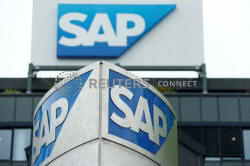SAP signals cloud intent as it ousts top in-house
programmers
 Send a link to a friend
Send a link to a friend
 [March 20, 2019]
By Douglas Busvine [March 20, 2019]
By Douglas Busvine
FRANKFURT (Reuters) - When business
software company SAP announced in January it would lay off 4,400 staff,
Chief Financial Officer Luka Mucic described the restructuring as a
"fitness program" for Europe's most valuable technology firm.
But what some of the German company's customers didn't expect was that
top software talent would be among those shipping out, rather than
shaping up.
Gone is Bjoern Goerke, chief technology officer and head of SAP's cloud
platform business, along with programming gurus Thomas Jung and Rich
Heilman - both highly respected in the wider SAP developer ecosystem.
The departures underscore CEO Bill McDermott's determination to deliver
on his long-stated ambition to drag SAP out of its comfort zone
providing old-school enterprise software and complete its transformation
into a digital platform business.
The shift comes at the risk of alienating core clients, who still
account for the bulk of SAP's business.
"The existing business must be supported with the necessary know-how,"
said Marco Lenck, chairman of the German-speaking SAP User Group (DSAG)
which represents 3,500 companies.
"We are seeing that a lot of people with know-how are leaving the
company. That's a trend that should not become too extensive."
Nine years into McDermott's tenure, SAP's transition remains incomplete:
Its legacy software license and support business remains its cash cow,
accounting for three-quarters of revenue and most of profits. However,
it is stagnating.

Its newer cloud operation is smaller and is growing quickly but, because
it is subscription based, has thinner margins.
McDermott, 57, has promised to treble the size of the cloud business by
2023, bringing total revenues at SAP to 35 billion euros ($40 billion),
as it competes with the likes of Oracle and Salesforce.com.
The latter is an all-cloud operation whose founder, Marc Benioff, wants
to achieve sales of up to $28 billion in 2023 - in the same ballpark as
SAP's own ambition.
McDermott's $8 billion takeover in November of Qualtrics, a U.S. firm
that tracks consumer sentiment online, showed he is ready, if necessary,
to pay top dollar for the talent needed for SAP to thrive in the digital
era.
"We are a growth company," the New Yorker said when he announced the
shake-up in January. He expects SAP's headcount - 96,500 at the end of
last year - to exceed 100,000 by the end of this year as new hiring
outpaces job cuts.
Asked for follow-up comment, SAP said the restructuring "will allow us
to invest in key growth areas while implementing required changes in
other areas to ensure they are prepared for the future".
For some, the plan is sound.
[to top of second column] |

The logo of German software group SAP is pictured at its
headquarters in Walldorf, Germany, May 12, 2016. REUTERS/Ralph
Orlowski/File Photo

"It's not about headcount reduction and savings, but talent re-alignment," said
Holger Mueller, an SAP veteran and principal analyst at Constellation Research.
DEVELOPERS FRET
But for fans in the SAP ecosystem that includes a wider community of developers
and business consultants, the departures are unsettling.
Dennis Howlett, a veteran consultant and co-founder of tech website Diginomica
https://diginomica.com/saps-restructuring-hunger-games-game-of-thrones-or-both/amp,
said SAP was letting go of "exceptional" talent to compensate for shortcomings
in its own cloud strategy.
"Bill McDermott says we are a growth company, but where is the growth coming
from, Bill, apart from acquisitions?" Howlett asked.
The trio, along with axed board member Bernd Leukert, were prime exponents of
the in-house programming language that has for decades been the beating heart of
SAP's range of enterprise software and database products.
Their expertise helped the company, based in the small Rhineland town of
Walldorf, grow into a $136 billion leader in applications - ranging from finance
to supply-chain management - that can be variably configured to meet client
needs.
"The software is like Lego, with pieces you can put together to make your
world," said Thorsten Franz, who runs an SAP consultancy in Germany and aired
his concern about the layoffs on social media.
"Apparently it was too good to last," he told Reuters. "Now SAP says: We don't
like the house any more, so we are firing the architect and all the people
working on it."
Jung and Heilman, who announced their departures this month on Twitter, declined
to comment to Reuters.
Goerke, who is based in Palo Alto and is known for dressing up as Star Trek's
Captain James T. Kirk at off-site events, could not be reached. His Twitter
handle suggested he was taking a time-out, carrying updates with poetry and
photos from his daily jogging outings.
The restructuring sends a message to SAP's existing clients that they need to
take seriously a 2025 'end of life' deadline for migrating users from legacy
products to its latest, cloud-compatible S/4HANA platform.
German users are pushing back: "We will fight to ensure that we continue to
receive support after 2025," said Lenck of the DSAG.
SAP says, meanwhile, that it still has to hold conversations with staff on its
restructuring in Europe. These are expected in the second quarter. The company
plans to offer a mix of early retirement and voluntary redundancy to staff.
(Reporting by Douglas Busvine; Editing by Mark Potter)
[© 2019 Thomson Reuters. All rights
reserved.] Copyright 2019 Reuters. All rights reserved. This material may not be published,
broadcast, rewritten or redistributed.
Thompson Reuters is solely responsible for this content. |